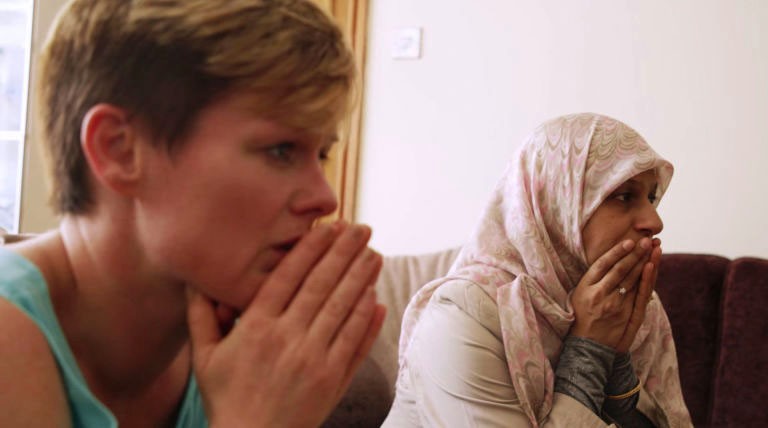
A television show where a white woman goes undercover to ‘understand’ Muslims has generated much debate

Dear All,
Television programmes trying to ‘understand who Muslims really are and what they really think’ have become somewhat of a staple on some British channels. And the latest, Channel 4’s My Week as a Muslim, in which a white English woman goes undercover as a Muslim woman and spends a week with a Muslim family has generated a fair bit of discussion and controversy.
In the programme, Katie from a very white village in Cheshire went and spent a week with Saima and her family in Manchester. Saima, a hijab wearing teacher with three hijab wearing daughters, bespectacled young son and one husband working overseas, welcomed Katie into her home and spent a lot of time telling her about Muslims and their way of life.
Although the project should ideally have been a learning experience for all participants, here the focus was on Katie overcoming her prejudice rather than on both parties learning from each other’s lives. Also, there was definitely a rather anthropological feel to the whole programme: ‘white explorer lives with a tribe to try to understand their society and way of life…’
This was further reinforced by the physical disguise the white woman was provided with to blend in with this Birmingham Pakistani Muslim family: her teeth had to be made more yellow, her eyes brown, her skin tone darker and her nose broader… As journalist Saima Mohsin remarked on Twitter: "So a British Pakistani Muslim has a big nose, yellow teeth, bad make-up, very very bad eyebrows" according to this programme.
At any rate Katie’s undercover week coincided (rather conveniently) with the terrorist attack on a big Ariana Grande concert in Manchester. In the aftermath of this suicide bombing by a young Mancunian Muslim, Katie was able to realise that, actually, Muslims are compassionate, community minded and ‘humans like you or me’.
One of the most interesting parts of the programme was when Katie goes by her local pub and gets heckled and abused. It gives her an interesting insight into what Muslims face on a regular basis, particularly in the wake of any terrorist attack involving jihadis.
There were a lot of scathing remarks about the programme, including criticism by Scottish National Party MP Hamza Yusuf and Conservative peer Baroness Syeda Warsi.
One user (@FindingMyLaw) tweeted that the programme "shows nothing but the fact that prejudice is only sympathised with when a white person experiences it", and the same sentiment was articulated by others including @KhurramAhmedLive -- "Because our oppression does not exist until a white person experiences and legitimises it."
#myweekasamuslim shows nothing but the fact that prejudice is only sympathised with when a white person experiences it
-- Nimra (@FindingMyLaw) October 24, 2017
But another one @fotosaad lauded the show saying, "more of the same please, people need to build bridges rather than burn them". And one of the show’s most well-known supporters was Adil Ray, the creator and actor of the tv comedy Citizen Khan. He tweeted praise for the show saying it showed "a person with preconceived ignorance trying to overcome it".
job well done @Channel4 for airing #myweekasamuslim, more of the same please, people need to build bridges rather than burning them
-- Saadia K (@fotosaad) October 24, 2017
My own problem with the show is that it was a bit of a one-way street -- it focused entirely on white prejudice and how white people’s notions can be changed by friendship and dialogue, but it did nothing to address conservative Muslim prejudices about white English people and their way of life. Although we are told at the end of the programme that "Katie and Saima remain close friends", it is unlikely that Saima would be quite so open about understanding Katie’s lifestyle.
Moreover, it introduced Katie to a conservative Muslim family where the patriarch was absent. If he had been present it is quite likely the women of the household would be doing the usual things like deferring to him, making tea for him, serving dinner to him first and so on. It is noteworthy that in one scene where the family members are praying together, the prayer is led by Saima’s son -- a mere child -- but perhaps superior because of being a male…
The thing about these media efforts to ‘understand British Muslims’ is that they always focus on hijab wearing and bearded individuals who wear their religion on their sleeve. Why not choose a family where there are various shades of Muslim -- some bearded, some not, some hijab wearing, some not, some observant, some not? That would really ‘humanise’ them!
The reality of Britain’s Muslims is that they are rather tired of being defined by the stereotypical Muslims being presented to them on television. Hijab is as much a part of Britain’s sartorial landscape now as wellies or jeans or punk clothes, but there are lots of Muslims in the country who consider themselves to be Muslim without having to wear long robes and affect Arabic accent.
They need to be ‘understood’ too….
Best wishes